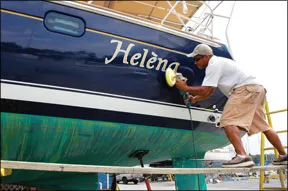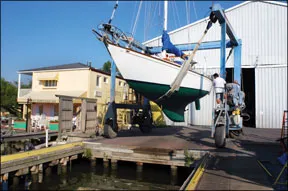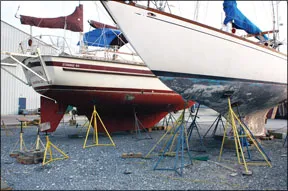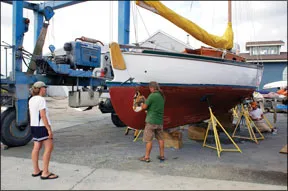The cost of buying, owning, and maintaining a sailboat has spiraled to an all-time high. The ranks of entry-level sailors, starting out in smaller boats, are thinning, and if both the industry and the consumer arent careful, mid-sized keelboat sailing will once again become an activity relegated to those of means.
Just stroll through any boat show and hear how easily six-digit boat prices roll off the tongues of todays production-boat dealers. Such pricing was pioneered by Hinckley, Morris Yachts, Swan, and other high-end builders, but now its trickled down to more mainstream sailboats at the same time marina slip fees, boatyard labor rates, insurance prices, and the cost of a quart of varnish have gone through the roof.

Photos by Ralph Naranjo
For many sailors, survival at sea has become a cash flow issue rather than a test of seamanship, and through do-it-yourself efforts, they have managed to keep the dream alive. Theres a three-fold approach to cost-effective boating: Buy a sound but older boat, keep it on a mooring rather than in a costly marina, and find a boatyard thats user friendly to the “do-it-yourselfer.”
Across the country, this third step is becoming less of an option. Do-it-yourself boatyards are an endangered species, and those of us who use them need to become more proactive about ensuring their survival.
As boat owners contend with more and more boatyard restrictions on what projects an owner can do, yard owners are facing pricing pressures that are exacerbated by escalating taxes, labor costs, and insurance premiums. These hardships have caused many a yard owner to throw in the towel and sell off to developers who have no intention of recapitalizing a boatyard-or even using the property in a “water dependent” context.
This restructure of the waterfront to non-water-dependent use is a land management failure that is happening in most every coastal community across the nation. Boat owners-particularly those of the DIY variety-should urge their local governments to draft waterfront redevelopment plans that are sensitive to boatyards and other “water dependent” operations like marinas and sailing clubs. It pays off when boaters make themselves heard at planning and zoning hearings. When a boatyard succumbs to real-estate pressure and is replaced by shops selling plastic oysters, T-shirts, and ice cream cones, the local recreational boater is the biggest loser.
The Business Side
Its important to keep in mind that boatyards are a for-profit business and a nautical rendition of fair trade should include good service for a reasonable fee. Its not unreasonable to expect the yards staff to have a well-maintained Travelift, Brownell trailer, railway, or crane to haul your boat. The operator should be skilled and by reflex should be able to get the slings properly positioned and your boat safely blocked.
However, if you deliver the boat with a genoa rolled up on a headsail furling system, don’t be surprised if youre charged extra for its removal. In fact, how a boat owner and their boatyard of choice treat a furled headsail says a lot about all involved. Insurance claims show that a significant amount of vessel damage has been caused by partially unfurled headsails capsizing blocked-up sailboats. All it takes is a volatile summer thunderstorm to lay waste to a vessel hauled with a furling headsail tied off to an upper shroud. In short, competent boat storage is a two-way street with both the owner and the boatyard steering the outcome.
Before hauling, make sure all the cards are on the table. Most yards have an information sheet, perhaps even a website, that lists the yards dos and don’ts, and spells out the scope of work that an owner can do on his own. Be sure to learn the rules regarding subcontracted work, a gray area that can cause serious dissension between yard staff and a boat owner.
Boatyards are in the business of selling labor, and their profitability revolves around keeping craftsmen busy. A yard thats willing to allow boat owners to do their own work is in some ways constricting its profitability, and the owner who tries to sneak in a subcontractor is “biting the hand that feeds.” Most yards have a service charge that applies to subcontracted work-some even encourage it-but whatever the case, owners that attempt to fly under the radar with owner-hired, incognito subcontractors have led many yards to clamp down on the DIY option and mandate that all work is handled through the yard.
The win-win strategy that will help maintain boat owners ability to do their own work is developing a good working relationship with the yard staff. The guy who comes into the shop asking to use tools and wondering where the “scrap” teak and stainless steel are kept does little to evoke a favored customer relationship. The DIYer who hires the yard to handle repairs and installations beyond his own skill and ability and develops a friendly relationship with the crew becomes a goodwill ambassador for all self-reliant sailors.
Picking the Right Boatyard
We looked for a good example of a small boatyard operation that was representative of yards around the country and set out to field test a simple boatyard ranking system, one that you can use to evaluate the facilities in your own backyard. (See “Reader Survey,” page 10.)
Galesville Harbor Yacht Yard on Marylands western shore of Chesapeake Bay is more casual than corporate. Theres a feeling that the owner and manager are as caught up in boating as we are, and its definitely the kind of operation where the staff makes a sailor feel at home. This sense of compatibility between a yard and a boat owner is important, especially if you like to work on your boat. Theres tangible value in having an enjoyable place to add the TLC your boat deserves,

particularly when youre likely to be spending a fair amount of time there.
The trend toward establishing boatyards on the least desirable parcels of land has caught on, and many are packed like a sardine and smell worse thanks to adjacent sewage-treatment facilities. Finding a nice place to work, with friendly folks to share a break with, is a luxury indeed.
What to Look For
Every skipper should go through a “what-if” scenario when considering a specific place to haul. These “what-ifs” include the potential impact of gale or storm-force winds, a significant tidal rise, and torrential rain.
Low-lying facilities exposed to the most volatile wind direction can spell trouble, as can a yard thats notorious for catching rain water runoff that turns a hard pan surface into soupy muck-destabilizing the jack-stands that support the blocked up boats.
Our sample yard, Galesville Harbor Yacht Yard is nestled in an estuary protected from the Chesapeake Bay as well as the ocean. During Hurricane Isabel in 2003, tidal rise presented the biggest concern there, but it was the vessels in the marina rather than those blocked up on land that suffered most. In other parts of the bay, more-exposed boatyards suffered from the extreme tide and the debris that swept through the hauled-out fleet, toppling jack-stands and the boats on them. Volatile winter storms can pack the punch of a tropical storm, so whether afloat or on dry land, a vessel needs to be able to endure the onslaught.
Equipment & Operator Skill
Frayed lifting slings, deteriorated pilings, and rusty machinery may still work, but more often than not, they are signs of the overall quality of workmanship that a boatyard has to offer. Those seeking lowest-cost options need to be especially aware of how their boat will be hauled and handled. When all is said and done, its hard to beat a new or well-maintained Travelift or hydraulic trailer. Equally important is the dock or ramp it operates on. But no matter how good the gear, the skill of the operator is the most important variable of all.
With sailboats, sling placement is crucial, and the geometry of the hull shape in conjunction with the cable lead adjustability on the lift will determine how equal the sling loading will be. Also critical is the cable angle, a factor that can lead to sling slippage, and in extreme cases, a vessel being dropped. A skilled operator will know how to handle various hull shapes and what rigging must be undone to fit a vessel into the confines of a Travelifts web.
One bit of boatyard wisdom worth remembering: “Being told that yours is the biggest vessel ever hauled by the facility should not be confused with words of encouragement.”
Cranes up the ante for concern, and their operation requires extreme care, especially if they are used to transport a vessel once it is hoisted from the water. Bulkhead collapse, tire failure, and changing ground angles can set the stage for disaster. Hauling via a Travelift, hydraulic trailer, and even the venerable marine railway are usually better options. Above all, if your boat is being hauled by a crane, be sure the operator uses “spreader bars,” a cage that keeps the sling load from compressing the hull.

The crew from Galesville favors a conventional Travelift that runs out onto a well-supported lift pier. Their setup is well protected from wind and sea. Eddie, the consummate lift operator, with decades of experience, knows both the capacity of his lift and the challenges of any given vessel.
When it came time to haul PS test boat Wind Shadow (an Ericson 41 sloop), Eddie had owner and PS Technical Editor Ralph Naranjo turn the boat around, release the back stay, and with runners set, he hauled the boat stern first. This was easier than removing a headstay and inner forestay, and allowed for better sling spacing. The efficient haul was followed by a thorough high-pressure washdown that removed all soft marine growth, leaving behind only a few tenacious barnacles at the bottom.
Blocking and Shoring
Standing up a vessel thats designed to float can be quite a challenge. In many cases, the hull skin is too thin to take the heavy point loading associated with too few blocks under a keel or near overextended pads or jack stands.
Properly executed, the blocking and shoring process is a means of spreading contact loads and rigidly supporting a vessel in a vertical position. Sailboats with external ballast easily endure the pressure imposed by keel blocks but may be troubled by the hull weight pressing down and flexing the keel/hull joint. Many lightly built race boats are fitted to special cradles that spread loads to numerous large contact points and allow the keel to hang.
In gale-force conditions, some race boats stowed in such a fashion, especially those stored with their masts still stepped, have been known to develop a pendulum-like keel motion that can capsize the cradle-supported boat. Wedging the keel bulb to prevent such an oscillation makes sense.
The GHYY yard crew used plenty of timber blocks for keel support and cross chained screw-jack poppets to provide both athwartship and fore and aft stability for Wind Shadow.
There is a subtle but significant difference between these three-legged stands. The ones with a narrower base are less stable and harder to use effectively. When supporting a sailboat with tripod like jack-stands, the idea is to extend an imaginary right-angle line from the hull skin to the ground at every pad point, and make the jack-stands centerline axis coincide with this line. The more it diverges, the more theres a tendency to “kick out” a stand if the vessel starts oscillating in high winds. Chaining the stands together lessens this likelihood.
Services
Once your boat is high and dry, a last check should be made to reduce windage, and the rigging that was loosened or disconnected for hauling should be reattached. Then its time to get on with the maintenance routine.

Well ahead of time a boat owner should work out with the yard manager what projects he wants the staff to shoulder and which ones he will be doing himself. Despite good intentions and prearrangements, most refits, even modest ones, lead to new discoveries and more work. Seldom does one find less to fix than originally planned. This is where the DIYer can make or break a relationship with a boatyard and the art of spending refit dollars efficiently is truly tested.
By noting in advance the skills of the craftsmen in the boatyard, you know whether or not appropriate expertise is available. However, fitting in more work can be a problem, especially during the spring rush. Thats why scheduling a haulout date after the fleet has been launched makes good sense. Also keep in mind that pestering a pro is-in a boatyard context-being a very “bad neighbor,” and just like asking where the “grab-bag” of scrap teak is kept, overbearing persistence hurts all do-it-yourselfers in the long run.
The Heart of The Yard
As with any business, the office is the central nervous system of a boatyard, a place where work orders are developed, time cards tallied, and bills are spawned. Its also where the “time is money” rule prevails, and during busy periods, distractions from boat owners looking for a casual chat are least appreciated. The dividing line between a friendly conversation and an unwelcome distraction is ill defined, but when DIYers are viewed by the yard staff as an annoyance, it isn’t long before the yard transitions into a “no owner work allowed” facility. Something to keep in mind when you seek out a work break in the AC.
On the other hand, the haul, store, and launch service holds the highest profit margin in the boatyard business, and quite a few smaller yards still hold to a business plan featuring a small staff and a willingness to allow owner-done maintenance.
Unfortunately, escalating costs are causing many to seek additional profit centers, and hiring a staff to handle mechanical, electrical, and paint work requires significant labor sales in order to offset the costs. Eliminating owner-done maintenance may initially keep technicians busier, but in the long run, many clients will look for alternate yards.
Working with boatyards that allow the do-it-yourselfer to thrive is a two-way street, and sailors need to do their part by making sure these boatyards remain a part of the ever-changing waterfront.





































